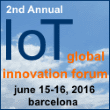

The Industrial Internet of Things (IIoT) and Industry 4.0 are becoming two of the most overused industrial automation buzzwords today, writes Dave Sutton a product marketing manager at Schneider Electric. The explosion in domestic Internet of Things (IoT) applications, such as smartphones, wearables and even fridges is a key driver for this, but is there more to it than the surrounding hype? (more…)
February 10, 2016
Posted by: George Malim

Who would have thought that the Internet of Things (IoT) could impact anything from artificial insemination of cows to supply chain management decisions, writes Nick Finch, the technical director of Concentra? (more…)
February 9, 2016
Posted by: George Malim

The first wave of connectivity to serve the continent of Africa was mobile communications; in fact more than double the population in sub-Saharan Africa (SSA) has mobile phone access compared with access to paved roads, writes Stephen Stewart, the regional director for Africa at Eseye. (more…)
February 8, 2016
Posted by: George Malim

IT is no longer the sole guardian of technology in the business. From IP enabled turnstiles to smart manufacturing systems that continuously monitor and optimise performance and smart buildings with IP connected environmental controls, the Internet of Everything (IoE) is slowly but inexorably expanding across every business environment, writes John Pepper, the chief executive and founder of Managed 24/7.
Right now, however, these deployments remain completely separate from the core business network – and IT has little or no visibility of IoE deployments. While companies are gaining operational benefits, these siloed deployments also represent significant operational risk. Security is the primary concern, but organisations are also missing out on essential business information. By failing to consolidate IoE deployments into the core network, organisations cannot enable CxOs to take advantage of a depth of real time analytics that should be informing changes to every part of the building, estate and production systems.
It is, therefore, no surprise that there is a growing CxO push to integrate IoE into the existing corporate network, not least to exploit IT’s security expertise. Few CxOs even consider any difficulties arguing, quite reasonably, that there is little or no difference between an IP enabled temperature sensor and any cloud based application. However, there is one fundamental and essential difference to consider: IT systems are still managed on the basis of 99.999% – five nines – availability; IoE demands 100% availability – failure is simply not an option.
A small but growing minority of IT organisations have therefore begun to explore the value of consolidating monitoring tools to move beyond break/fix to a predictive model that delivers 100% uptime. End to end monitoring that accurately predicts trends in performance combined with self-healing technologies both prevent problems and enable organisations to achieve far more effective IT utilisation.
Given the speed with which devices are becoming Internet enabled, there is no time to delay. But organisations have some tough questions to consider. From ownership to budget, capacity planning to network audit and security, organisations need to determine where the responsibility lies for this new connected model – and, critically, ensure IT embraces the predictive approach required to deliver the 100% availability now required of these essential systems.
The role of IT is changing; today’s requirement to support servers is evolving fast to one that is about managing millions of connected devices, from coffee machines to life saving NHS equipment. IT needs to step up quickly to embrace this critical, predictive model for every aspect of the corporate infrastructure.
February 5, 2016
Posted by: George Malim

The Internet of Things (IoT) has truly begun to take off with enabled devices including smart watches, smart meters and connected cars as well as smartphones and tablets, writes David Watkins, the service delivery director at Virtus Data Centres. However, technology and appliances are not the only industries affected by this growing trend. In fact, IoT’s potential reaches far beyond, and could play a major role in helping disconnected industries re-engage with their customers. (more…)
February 3, 2016
Posted by: George Malim

February 2, 2016
Posted by: George Malim

One of the many sizable challenges in healthcare today is ensuring patients are taking care of themselves: taking their medication on time, getting enough sleep, doing what the doctor has advised, and maintaining a healthy lifestyle, writes Mathew Kuruvilla, the chief innovation officer of Ness Software Engineering Services. (more…)
January 22, 2016
Posted by: George Malim

Stuart Wilson, the vice president for EMEA at Alteryx, highlights how the Internet of Things (IoT) is set to propel businesses to discover geospatial analytics all over again this year. (more…)
January 15, 2016
Posted by: George Malim

Event date: June 15-16, 2016
Barcelona, Spain
The 2nd Annual IoT Global Innovation Forum, June 15-16, 2016 in Barcelona, Spain, brings together leading technology innovators, business strategists and developers from around the world for two days of focused networking and information sharing at the IoT cutting edge. Expert speakers will discuss the latest applications for traditional commercial processes as well as new business models and opportunities within the emerging Internet of Things ecosphere. (more…)
January 14, 2016
Posted by: IoT global network

Rob has served as chief marketing officer and senior vice president of products at ForeScout since June 2015. Prior to joining ForeScout, he served as vice president and general manager of the Network Security division at HP Software, where he was responsible for determining product strategy, delivery, customer success and overall P&L. Before that, Greer served in numerous leadership roles at Symantec, ClearApp (acquired by Oracle), SonicWALL, and Ignyte Technology, where he was founder and chief executive officer. He earned a Bachelor’s degree in Management Information Systems from San Jose State University.
January 11, 2016
Posted by: George Malim